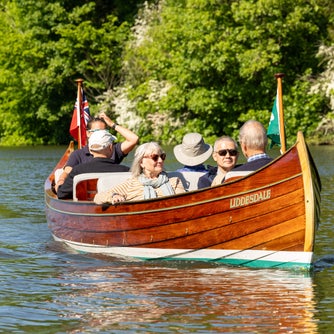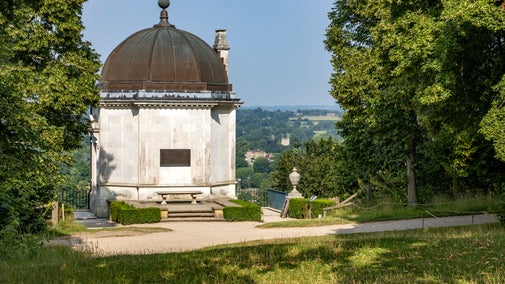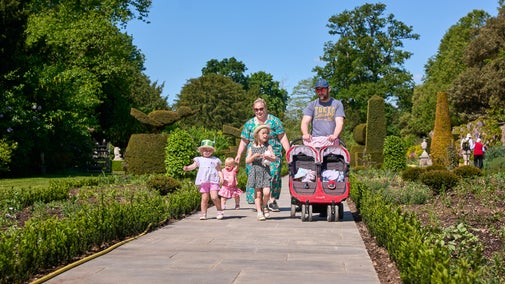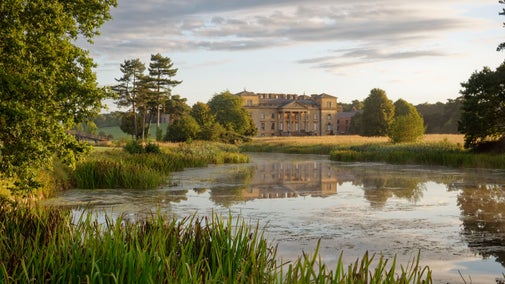
Donate
Everyone needs nature, now more than ever. Donate today and you could help people and nature to thrive at the places we care for.

Across the Grade I listed garden and within the house itself, now a luxury hotel, we have undertaken several conservation projects over the past few years. This historic estate requires regular upkeep, conservation of historic structures and restoration of individual features to keep it looking its best for everyone to enjoy for ever.
The house, which now operates as a private hotel, had work carried out to maintain the fabric of the building in 2021. This included renewing the roof covering to the area above the laundry and the refurbishment of the timber framed lantern rooflights. The project includes improvements to the rainwater apparatus serving the roof, and the provision of thermal insulation to the roof.
Cliveden's oriental-inspired water garden generates year-round interest, particularly the spring blossom and autumn colour. The centrepiece of the garden is the six-sided Chinese Pagoda, which has been restored to its original green with an intricate gold patterns colour scheme.
The restoration project ran in two phases from 2019 to 2021. Phase 1 focused on enhancing the planting along Green Drive Path, a 200-year-old path used by generations of visitors to Cliveden that runs the length of the Water Garden from the bamboo gates to the entrance to the woodland. Planting included oak and hazel, important native species, grown from acorns and hazelnuts collected from across the Cliveden estate.
Phase 2 revived the oriental planting scheme first created by the Astor family in the late 1890s and early 1900s. This phase began in 2020 and included extensive pond restoration and replanting with vibrant aquatic plants including water lilies and oxygenating species.
An oriental planting palette was introduced to the banks and surrounding beds, including a variety of evergreens, deciduous shrubs and trees, perennials and bulbs, adding to the existing mature shrubs and tree planting that give the water garden its structure.
Cliveden has always made the most of its position on the Thames, never more so than during the early part of the 20th century when the Astor family and their guests enjoyed pleasure cruising along Cliveden Reach, a stretch of the river running below the house.
One of the Astor’s boats was a specially commissioned electric canoe named ‘Liddesdale’, beautifully constructed from mahogany. Electric canoes were very popular at the time, running silently and elegantly on battery power.
When the Astor family left Cliveden, the electric canoe was sold. Twenty-five years ago, the Liddesdale came back to Cliveden when the Cliveden House Hotel bought it. However, by 2016 the canoe had fallen out of favour and into disrepair. Thanks to the generosity of donors, the National Trust acquired this once-cherished vessel. A fundraising appeal raised £25,000 for restoration to take place and in 2019 boat builders worked on the canoe inside Cliveden’s Boat House.
This project has ensured the survival of one of the UK’s few remaining historic electric canoes and enabled everyone to enjoy canoe trips just like the Astor family did along Cliveden Reach, on the very same stretch of the Thames that entertained guests at Cliveden for centuries.

History and Restoration of Nancy Astor's electric canoe 'Liddesdale' at Cliveden
For over 70 years, the Generator House was the key ingredient in allowing Cliveden to bask in glorious heat, light and throw glamorous parties. Only a stone’s throw from the main house, tucked away in 'the Dell', this significant example of groundbreaking engineering remained hidden from public view. Between spring of 2017 and 2019, thanks to a £50,000 regeneration project, the building was made watertight with a new roof and guttering.
The Tortoise Fountain is a unique structure with two tiers, each with four features. On the top tier are the eponymous tortoises, technically terrapins, and on the second tier are lion heads. The bottom basin boasts intricately carved Medusa heads forming three superimposed basins. Adjacent is a curved stretch of red brick and stone balustrade wall derived from the Borghese Balustrade.
The project restored the fountain’s original splendour and artistic intention, ensuring the fractured travertine rim on the bottom basin was made watertight and stable. The fountain’s waterworks were repaired to allow flow to all the spouts.
As you wander through Cliveden's Water Garden, you may spot a few additions to the Chinese Pagoda. Since being brought to Cliveden by William Waldorf Astor in 1900, the Pagoda has gone through several significant changes and the replacement of the Pagoda bells are no exception.
Reminiscent of the architecture of the Orient, the Pagoda bells aren’t just an attractive addition to the outdoor display. The sounds produced by each bell create a unique and special chime. Therefore, unsurprisingly, the replication process involved some extremely detailed designs and painstakingly structured drawings. Assisted by National Bells Advisor Chris Pickford, the replacement project began with some extensive research into the original bells. The bells were made with iron, oil gilded and applied with 24-carat English gold and painted inside with a traditional bronze patina.
George Hamilton, 1st Earl of Orkney, hired Venetian architect Giacomo Leoni to design two beautiful structures at Cliveden in 1727. Blenheim Pavilion was one of them, proposed as a nod to his military success.

In the past, dry rot has been a real problem in the pavilion. Much work has been done over the years to deal with that issue and as a result, quite a lot of the original, historic surface has been lost. The project aimed to remove all the inappropriate plaster and return to the original scheme as intended.
Thankfully, because of Leoni’s original drawings and photographs from the early 20th century, we had strong evidence of what it once looked like. Interestingly, it seems that all the original plasterwork was painted in an imitation of stone, a fashionable practice often used in the Palladian style that Leoni favoured.
Although vestiges of Orkney’s influence can be seen around the estate there are very few signs left of this time in Cliveden’s history. Here we have a spectacular symbol of the Georgian era, a link to Blenheim Palace and the War of the Spanish Succession.
After 150 years of sheltering boats used by owners and guests alike, it was time for the exterior of Cliveden's Victorian Boathouse to be given the attention it sorely needed.

The restoration project entailed extensive repairs to the decorative windows made of small glass sections, finding like-for-like replacements of the layered clay tile roof, and breathing new life into this hidden jewel on the estate.
It’s easy to take for granted, but Feathers Gate has been welcoming guests to Cliveden since the 19th century. The gates used to stand slightly west of their current home but were finally brought to this spot after 1901 and have stood tall here ever since; a beautifully grand greeting for those who came to call.
As part of the project a volunteer statue cleaning team were tasked with cleaning the two large stone urns that sit on top of the main gate piers. This protected the stone against further decay, preserving this grand entrance for future generations to experience and enjoy.
Although the gates were structurally sound, the ironwork and some areas of masonry showed signs of decay. Traditional techniques were used to replace failed mortar, clean, carry out conservation repair and bring the intricate ironwork back to its best.
After 350 years of use, time had taken its toll on Cliveden's South Terrace and below Sounding Chamber. Five years and £6 million pounds later, the conservation project restored this part of the estate to its former glory.
The South Terrace is thought to be the oldest surviving structure at Cliveden. With alterations and repairs along the way, it's survived two fires and over three centuries of Cliveden wind and rain. But sadly, the damage to the Terrace became more and more obvious as the years went by. Faulty drainage meant significant water damage caused water to soak into the stone, accelerating the decay. The original balustrade was also showing its age. The 17th-century stonework was barely being held together as the crumbling masonry began to wither.
Work on the Terrace included painstakingly taking up the Terrace flagstones, repairing the cracks, and then re-laying them in their original formation. The defective drainage system, which caused some of the deterioration to the Terrace itself, was also replaced.
On the western side of the terrace, where the Cockerell Pavilion sits, some much needed repairs were made to the brickwork, securing the structure of the building.

Everyone needs nature, now more than ever. Donate today and you could help people and nature to thrive at the places we care for.

Take a guided tour of Cliveden house – now a luxury hotel – and visit the chapel, final resting place of three generations of Astor family.

Discover the background and history of some of the main features in the garden at Cliveden and who was responsible for commissioning and designing them.

Discover all about the popular pastime of boating, links to Wind in the Willows, and how to hire a boat to enjoy the River Thames at Cliveden.

From fun walking trails to boating on the Thames this summer holidays, this is your one-stop shop to help you get the most out of your family visit to Cliveden.

We believe that nature, beauty and history are for everyone. That’s why we’re supporting wildlife, protecting historic sites and more. Find out about our work.

Find out more about the funding the National Trust receives from grants, and the projects it has helped support.